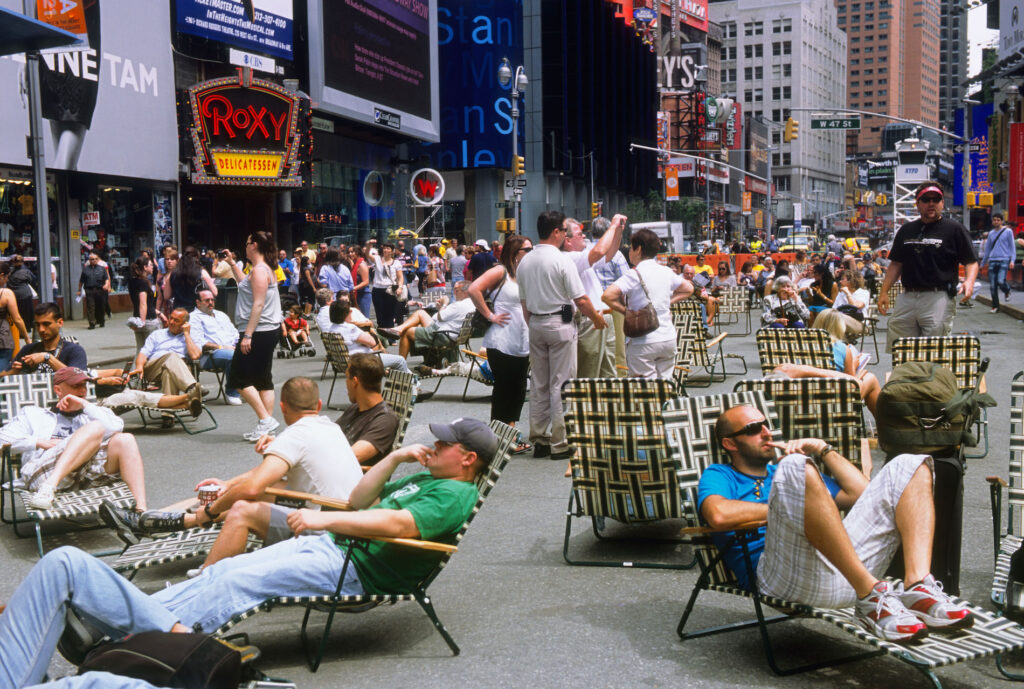‘What is the city but the people?’—Coriolanus, William Shakespeare
In order to compensate for the bureaucratic inflexibility and sluggishness that is burgeoning in spatial design, a new methodology has evolved that enables to operate in a more democratic, playful, experimental and cost-effective way.
Merriam-Webster dictionary defines ‘tactical’ as ‘relating to small-scale actions serving a larger purpose’ or ‘adroit in planning or manoeuvring to accomplish a purpose’.1 Transposing this to the context of the city, Tactical Urbanism (TU) consists in the design and activation of neighbourhoods by using inexpensive short-term interventions and actions that are scalable. In his book The Practice of Everyday Life, French philosopher Michel de Certeu describes (in the context of the city) strategies as the official tool of those with power (i.e., the authorities), and tactics as the response of the powerless (the citizens). Mike Lydon and Anthony Garcia, the stars of the TU movement, do not see these two interest groups in such adversarial terms, but rather as two poles that ideally should be in dialogue. Just like citizens should gradually come to understand strategies, so should governments learn to act lissomly and tactically rather than limit themselves only to carrying out slow major projects.
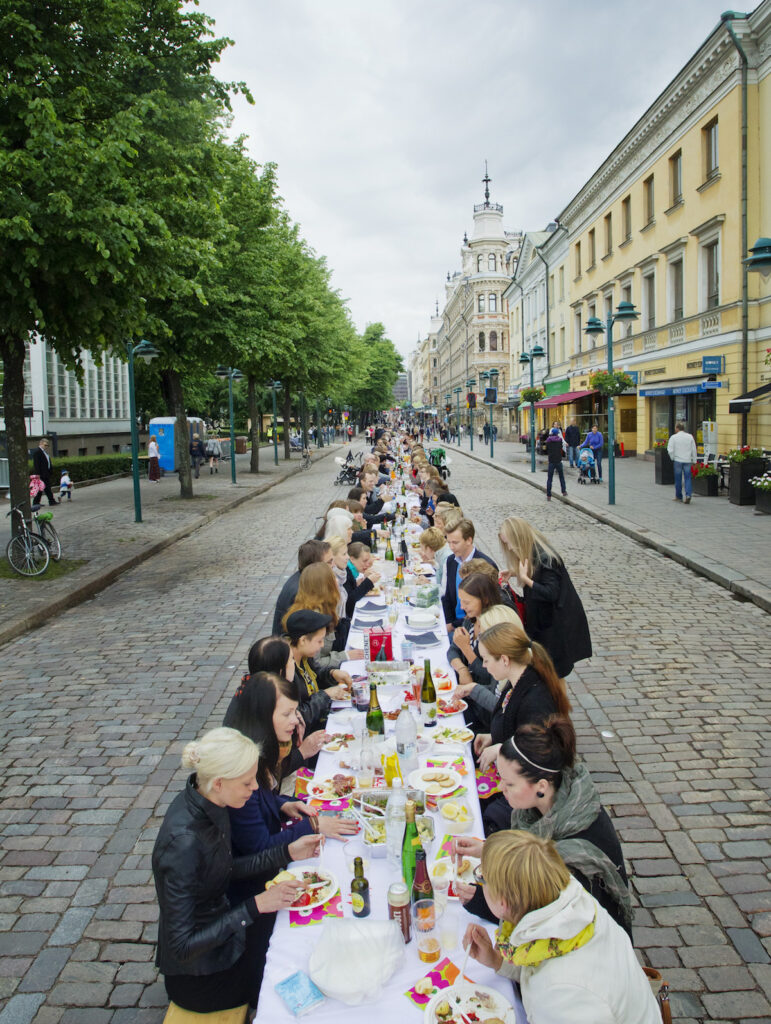
Lydon and Garcia state2 that the three most important applications of TU are in
1) civic actions that enable to bypass slow official procedures, voice protest or visually demonstrate the possibility of changes;
2) in the hands of cities, developers or NPOs for cooperating more closely with the public in the planning and development phase;
3) and in the so-called ‘phase zero’ approach of developers and cities for testing an idea before making a large investment to implement it.
The three are not mutually exclusive—rather, one activity is bound to lead to others over time.
Planner and engineer Chuck Marohn has described TU aptly as a method that helps to transform an extremely disciplined, but stupid (planning) system into something that is more chaotic and smarter—something that allows the budding citizen networks and ideas to evolve and improve the quality of life on the neighbourhood level. In the established system of administering cities, the so-called software (culture, codes, policy) that has been created for implementing necessary urban services (planning, engineering, building, public services) inevitably materialises in the hardware of the city, i.e., buildings, streets, and parks. Due to their complexity, processes have become so slow and cumbersome that they no longer meet the actual needs of the society. Since we have a continued need for ‘hardware’ (and updating it), we must take a critical look at the ‘software’. TU enables us to correct mistakes in real time and develop ideas by testing them out in actual physical space. The results may vary, but the process itself is reliable, for the principles are the same as in, say, scientific research.3
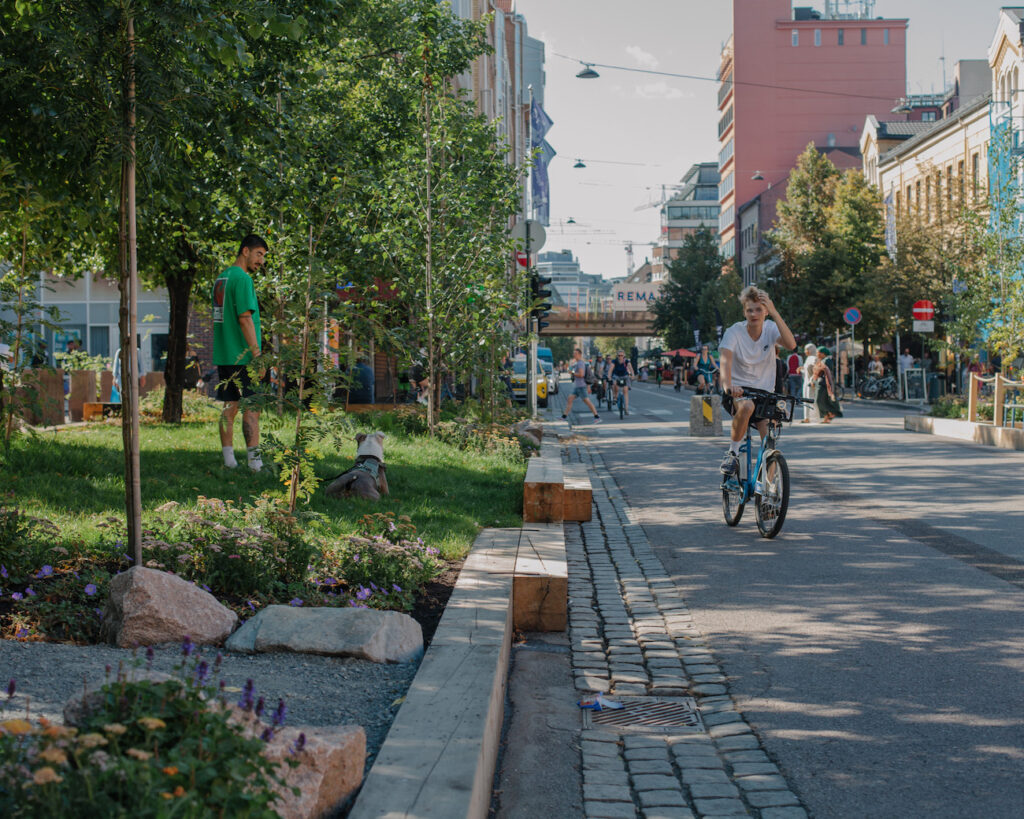
The fight for streets
The street qua the most common form of public space has historically been where people walk, play, socialise and engage in commerce. In the 20th century, however, most streets became anonymous, noisy, and unpleasant transit hubs, and gradually lost much of their historical values and spatial quality. This is also a reason why much of modern urbanism, including TU, focuses namely on the streets, taking pains to restore these original values and making them into Places again.
The Dutch word woonerf (i.e., ‘living street’) has become a key term. The concept was born in the 1960s in the city of Delft and had the purpose of restoring the life quality that streets could offer, preferring it to speed and traffic capacity. The latter is a term that is used in a particularly unscientific way by car evangelists, for in their models, throughput of cars has been artificially prioritised, although this is, due to physical constraints, by far the smallest when compared to the throughput of all other kinds of mobility. One of the first protest actions by the citizens of Delft was to tear up the street paving during night where it was necessary to slow down car traffic. Over time, such actions, born out of an illegal intervention, turned into a politically legitimate toolbox (although without an illegal change of paving), and today, they have become an internationally acknowledged standard for creating safe, commonly shared streets.
TU is often applied in places where improper planning has led to unpleasantly empty, extensive, and non-human-scale spaces, but in which spatial enthusiasts—hacktivists, NPOs, developers or the public sector—see some potential. Often, the problematic places are directly or indirectly related to the infrastructure created for cars. Such places are, for instance, empty plots, parking lots and parking places, empty storefronts, overly wide streets, areas under flyovers, and other non-places. Those engaged in TU see space as a physical and social laboratory where you can test out your ideas in real time and observe the effect of changes on people’s behaviour.
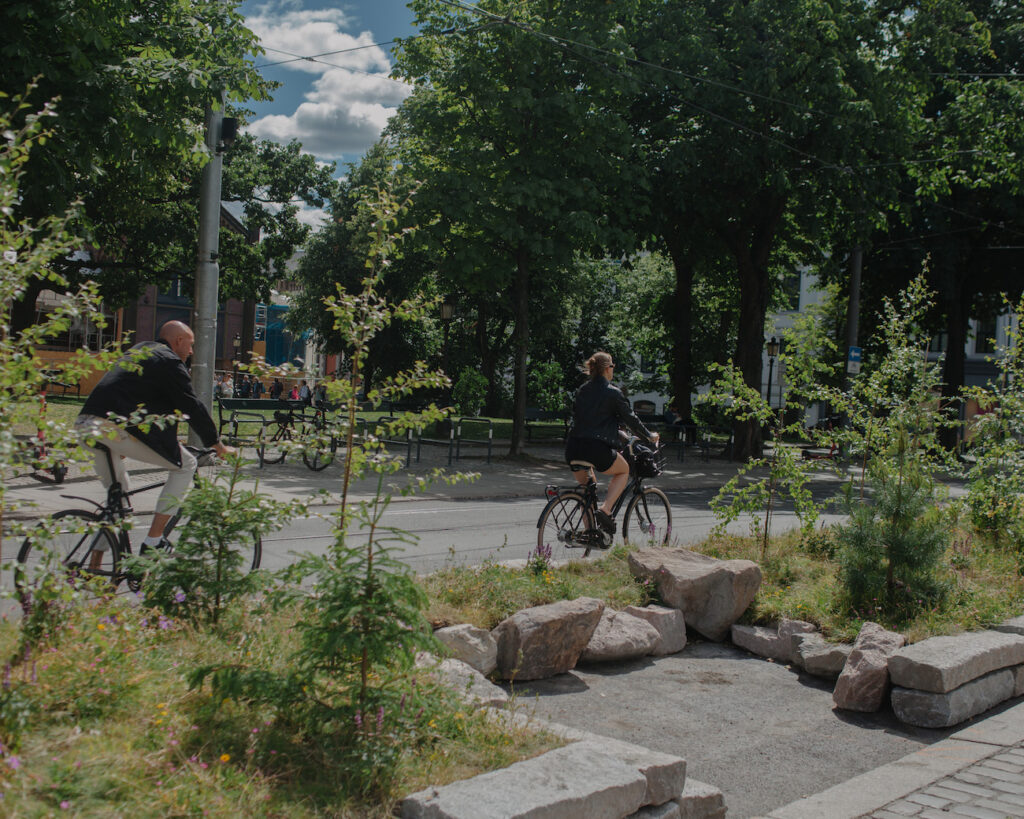
From time to time, TU-style interventions are also needed in recently completed, thoroughly designed new and pretty environments, because, as it turns out, sometimes creating a pretty environment is not sufficient for creating a vibrant environment—this was illustrated by the Rose Kennedy Greenway, a linear park built on a former highway in Boston, which turned out to be quite unpopular after it opened. Only with later interventions—e.g., container greenery and moveable outdoor chairs—and a cultural programme, and the arrival of food trucks, the place truly became alive. Indeed, Lydon and Garcia see the main value of TU in bestowing places with a sociocultural programme and daily public rituals, which make up the foundations of life and being in the city, and the basic needs of homo socialis.
The rich catalogue of TU actions and the history of their implementation offer highly inspiring, tried-and-true methods for the social empowerment of spaces. Often, people first get involved with actions that border on illegal, such as drawing guerrilla crosswalks on dangerous street sections, or adding unauthorised benches to places in which they are missing. A more forceful kind of intervention by the community and activists is ‘Build a Better Block’, where some lifeless street space that is designated for cars is temporarily occupied and filled with activities that invite people to spend time there and force the traffic to slow down. A similar effect is achieved by the so-called intersection repair, where the asphalt of an intersection is adorned with art (rendering the dull dark surface livelier, and also slowing down traffic by visually disturbing the drivers), or by community projects such as book exchange points.
Due to their obvious benefits and popularity, unauthorised actions often end up being approved by public authorities and start to spread like wildfire to other districts as well. Methods that have been approved by public authorities include creating public squares or parks out of pedestrian and car roads, restricting car traffic, and organising (as has also been done in Estonia) playground streets, pop-up cafes, and pocket and container parks. One of the largest transformations that got started from a TU-style movement was probably in the extremely car-centric city of Dallas, where spatial activist Jason Roberts made a webpage for Oak Cliff neighbourhood tram enthusiasts; this concentrated a lot of interest and ended up putting so much pressure on the city that it is now restoring its tram network, closed down 70 years ago.

To whom does public space belong ?
It is no secret that besides its role in spatial design, TU is also a mechanism for interacting with and swaying public authorities. It has been particularly interesting to read about and observe the reactions of public authorities to various activities. There are always some who rain down threats on the troublemakers and turn back any changes at the first opportunity. One tactical intervention by citizens was followed by a now-legendary public meeting in a U.S. municipality, where an emotionally distraught official blurted out, ‘Public space does not belong to the public!’—which only fuelled the fire of the activists’ fervour.
Nevertheless, the more open-minded (and pragmatic) ones in power have generally been quick to notice the positive benefits of TU actions, which are usually hard to resist—the changes are simply so obvious and tangible that they quickly gather broad-based support. An important role is also played by the (social) media. Estonian TV show ‘Laser’ organised a traffic experiment4 in which they demonstrated a hazardous road section with the help of tomatoes, and the reaction of a certain official became the symbol of bureaucratic inflexibility and hostility, thus helping to galvanise the public—not to mention giving us the wonderful semiotic game offered by the image of crushing tomatoes.
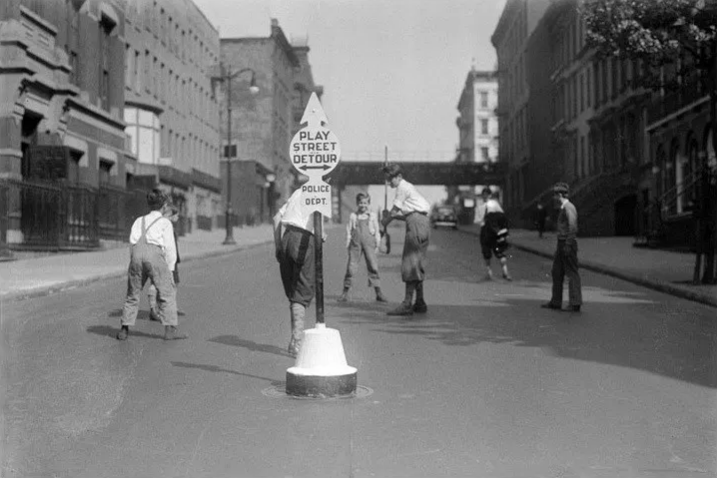
A.C. Wharton, the former mayor of Memphis, formulated the values of TU from the standpoint of urban planning and public sector very concisely: ‘Too often, cities only look to big-budget projects to revitalise a neighbourhood. There are simply not enough of those projects to go around. We want to encourage small, low-risk, community-driven improvements all across our city that can add up to larger, long-term change’.5 These golden words were also followed by actions—Memphis has systematically adopted the TU methodology in its urban planning, and by now, there are cities using this methodology on every continent.
Probably the most convincing proof against the notion that TU interventions merely realise the phantasies of ‘leftist ideological warriors’ at the expense of others’ welfare and have no use in fighting against motorisation, came from Barcelona, where it was scientifically shown that creating good spaces and restricting cars does not simply lead to redirecting the traffic. Over 14 days, TU methods were used to reduce car traffic in certain areas of Barcelona. Checkpoints in those areas, but also elsewhere in the city measured the traffic volumes to see if reducing traffic in one place merely redirected it to another. The results showed that besides the expected decrease in the areas of active intervention, there was a slight decrease even in those checkpoints to which traffic might have been expected to move. Instead of being redirected, traffic simply ‘evaporated’.6
One very important value of TU for the public sector is precisely its ability to allay various NIMBY-mentality-related fears, which often have to do namely with cars. ‘Sommerville by Design’ is a municipality-initiated TU programme, which was born after local citizens stood up against a new plan to redraw certain streets. Mostly, they were upset by a plan to turn one small parking lot into a car-free square. After this, the local authorities, with the help of activists, turned a small parking lot into a vibrant (car-free) square for three days, and the popularity of the result managed to demonstrate to the locals the charms of a car-free space. In Estonia, these charms are demonstrated vividly by the Car-Free Avenue in Tartu, street festival ‘Tulevik on täna/v’ (‘Future is Today/the Street’) in Tallinn, and restrictions during the Opinion Festival in Paide, each of which have also enabled to test the emotional soil for a potential permanent transformation of some street. The end result depends, of course, on how the power struggle with the car enthusiasts among locals, visitors, and also journalists is going to play out. Recall, for instance, the op-ed titled ‘Brain-Free Avenue’7 in Tartu Postimees, which failed to foresee the enormous popularity of the forthcoming event.
As it has been shown by several spatial design-oriented TU actions, like the ‘Build a Better Block’ activities and intersection repair projects, a benefit that is possibly even more important than the spatial changes is the formation of new social networks and fellow feeling for communities, which does not merely generate more motivation for people to spend time outside, but also encourages them to think along and act with the aim of turning the ‘outside’ into a more pleasant place. The latter issue is especially acute in Estonia, where a considerable part of the society seems to be encapsulated in their homes during their free time, and where there are whole districts that lack good public space—a problem that surely won’t be made any better by the pressure from residential district apartment associations to turn their green spaces into parking lots. In this respect, activist cells such as Elav Tänav (Living Street), Lasnaidee and Paide Wabakond, are an invaluable asset whom the local authorities should advise and support, and whose methods should be learned from.
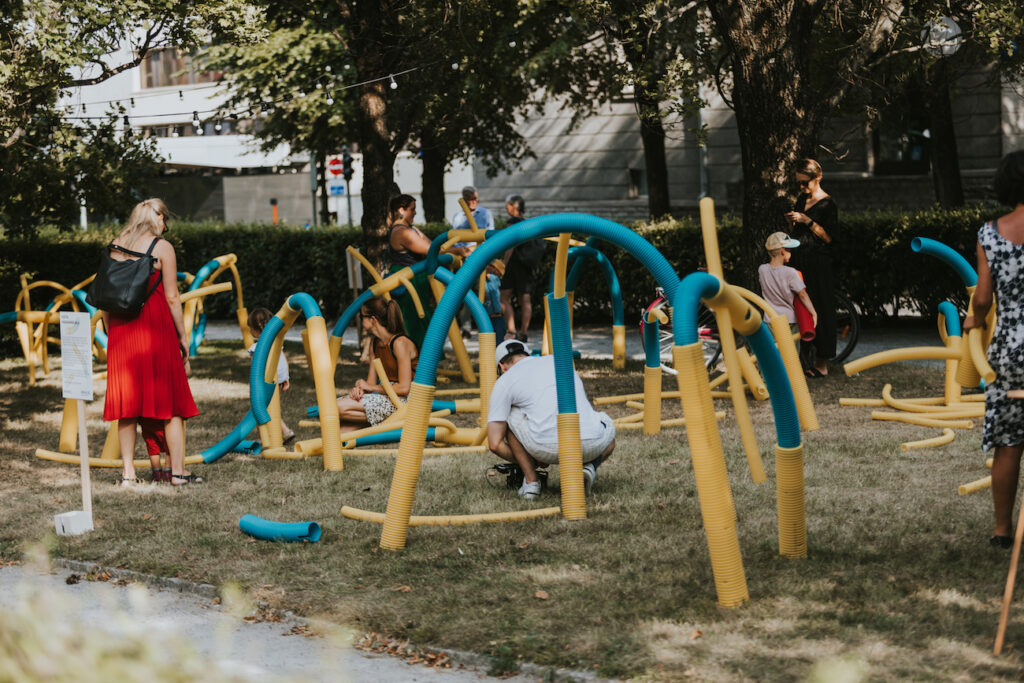
Preparing for the age of permacrisis
Art historian Boris Groys has commented that ‘crisis is the dialectical lubricant of capitalism’. Extrapolating from this, one could say that it is also an accelerator for Tactical Urbanism. In the last decades, TU has gathered strength in the face of neoliberal excesses, whose spatial expressions include oversized high-rises and car infrastructure objects as well as sprawling, resource-costly suburbs, due to which the area of urban settlements has begun to grow several times faster than their population. Given that urban sprawl is ecologically, spatially, and economically the most wasteful kind of settlement (for both the resident and the municipality), the enormous boom-era ‘box villages’ in the U.S. turned out to suffer the most from the 2008 recession, and today, the number of people below the poverty line is larger in the suburbia than in the cities. Given our current capitalistic way of life, suburbia simply lacks the necessary resilience.
In a similar way, public-space-related shortcomings were acutely highlighted by the recent pandemic. For cities with a more agile mindset, this provided a direct impetus to build a lot of bicycle roads, close down car roads, and open outdoor cafes and restaurants. The first quick steps were often taken with tricks derived from the TU methodology. For instance, in the case of the bicycle roads in Tallinn City Centre, which were completed in 2022 immediately before the elections, several planning stages and standards were quietly circumvented in order to achieve rapid results.
The need for urban densification has been much discussed both here and elsewhere (albeit much less implemented), but the important thing is that densification should be accompanied by high-quality, vibrant spaces that tackle the main problems of cities—noise, pollution, lack of greenery and social alienation. Tactical urbanism has its own means for addressing nearly all of these issues—we only need to have courage and an open mind, and to understand that in a democratic society, spatial design could likewise be an inclusive, collective, experimental process, which organically involves trial-and-error, readiness to fail, and an opportunity to learn from one’s mistakes.

HANNES AAVA leads tactical interventions’ project Green Tracks (Rohejälg) at Tallinn Strategic Management Office, studies landscape architecture and writes on spatial topics.
HEADER: Historically car-centric New York Times Square was recently made largely car-free; photos of the beach chairs there have become a classic of Tactical Urbanism. According to Janette Sadik-Khan, the legendary commissioner of the New York City Department of Transportation who was behind the decision, the idea was born less than 24 hours before closing the street. Photo by Sandra Baker / Alamy Stock Photo
PUBLISHED: Maja 111 (winter 2023) with main topic Street Unrest
1 https://www.merriam-webster.com/dictionary/tactical
2 Mike Lydon, Anthony Garcia, Tactical Urbanism—Short Term Action for A Long Term Change (Island Press, 2015)
3 Charles L. Marohn Jr., Strong Towns: A Bottom-Up Revolution to Rebuild American Prosperity (New Jersey: John Wiley & Sons, 2020)
4 https://www.tv3.ee/3-portaal/tele-ja-kino/laser/marii-karell-varskes-laseris-see-mis-juhtus-meie-eksperimendis-tomatitega-voib-kahjuks-juhtuda-liikluses-pariselt-inimestega/
5 Pagano, Celeste DIY Urbanism: Property and Process in Grassroots City Building. Marquette Law Review, issue 2. 2013
6 Samuel Nello-Delkin, ‘Exploring traffic evaporation: Findings from tactical urbanism interventions in Barcelona,’ Case Studies on Transport Policy 10, no. 4 (December 2022): 2430-2442, https://www.sciencedirect.com/science/article/pii/S2213624X22002085
7 Rannar Raba, ‘Ajuvabaduse puiestee’, Tartu Postimees, June 5, 2020, https://tartu.postimees.ee/6989468/rannar-raba-ajuvabaduse-puiestee

